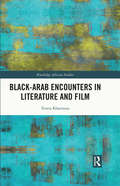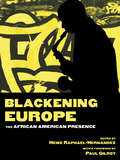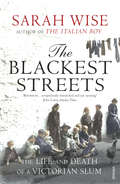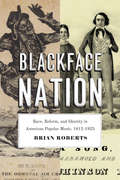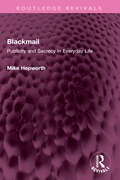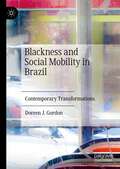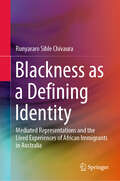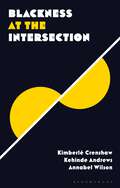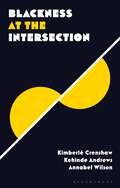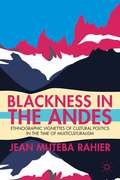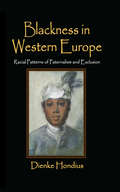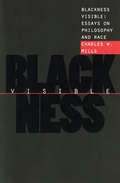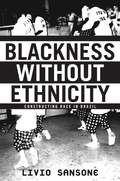- Table View
- List View
Black–Arab Encounters in Literature and Film (Routledge African Studies)
by Touria KhannousThis book investigates how representations of Black Africans have been negotiated over time in Arabic literature and film. The book offers direct readings of a representative selection of primary texts, shedding light on the divergent ways these authors understood race across different genres, including pre-Islamic classical poetry, polemical essays, travel narratives, novels, and films. Starting with the first recognized Black-Arab poet Antara Ibn Shaddad (580 C.E.) and extending right up to the present day, the works examined illuminate the changes in consciousness that attended Black Africans as they negotiated their position in Arab society. In a twist to Edward Said’s Orientalism, the book argues that scholars in the Middle East and North Africa generated a hierarchical representational discourse themselves, one equally predicated on the Self-Other binary. However, it also demonstrates that Arab racial discourse is not a linear rhetoric but changes according to history, political circumstances, and ideologies such as tribal politics, the Shu’ubiyya movement, nationalism, and imperialism. Blacks and Arabs have had tangled relationships that are based not only on race but also on kinship and solidarity due to trade and other types of connections. Challenging fundamental assumptions of Black Diaspora studies and postcolonial studies, this book will be of interest to scholars of the African diaspora, Arabic literature, Middle East studies, and critical race studies.
Black–Arab Encounters in Literature and Film (Routledge African Studies)
by Touria KhannousThis book investigates how representations of Black Africans have been negotiated over time in Arabic literature and film. The book offers direct readings of a representative selection of primary texts, shedding light on the divergent ways these authors understood race across different genres, including pre-Islamic classical poetry, polemical essays, travel narratives, novels, and films. Starting with the first recognized Black-Arab poet Antara Ibn Shaddad (580 C.E.) and extending right up to the present day, the works examined illuminate the changes in consciousness that attended Black Africans as they negotiated their position in Arab society. In a twist to Edward Said’s Orientalism, the book argues that scholars in the Middle East and North Africa generated a hierarchical representational discourse themselves, one equally predicated on the Self-Other binary. However, it also demonstrates that Arab racial discourse is not a linear rhetoric but changes according to history, political circumstances, and ideologies such as tribal politics, the Shu’ubiyya movement, nationalism, and imperialism. Blacks and Arabs have had tangled relationships that are based not only on race but also on kinship and solidarity due to trade and other types of connections. Challenging fundamental assumptions of Black Diaspora studies and postcolonial studies, this book will be of interest to scholars of the African diaspora, Arabic literature, Middle East studies, and critical race studies.
Blackbox Algorithmus – Grundfragen einer Regulierung Künstlicher Intelligenz
by Mario MartiniDieses Buch liefert eine rechtswissenschaftliche Analyse der Chancen und Gefahren algorithmenbasierter Verfahren. Algorithmen, die im Maschinenraum moderner Softwareanwendungen werkeln, sind zu zentralen Steuerungsinstanzen der digitalen Gesellschaft avanciert. Immer nachhaltiger beeinflussen sie unser Leben. Ihre Funktionsweise gleicht aber teilweise einer Blackbox. Die in ihr schlummernden Risiken zu bändigen, fordert die Rechtsordnung heraus. Das Buch beleuchtet die gesellschaftlichen Gefahren einer zunehmenden gesellschaftlichen Steuerung durch Algorithmen und entwickelt erste Regulierungsideen, mit deren Hilfe sich die Wertschöpfungspotenziale automatisierter digitaler Prozesse mit den Grundwerten der Rechtsordnung versöhnen lassen.
Blackening Europe: The African American Presence (Crosscurrents in African American History)
by Heike Raphael-HernandezTraditional Scholars have often looked at African American studies through the lens of European theories, resulting in the secondarization of the African American presence in Europe and its contributions to European culture. Blackening Europe reverses this pattern by using African American culture as the starting point for a discussion of its influences over traditional European structures. Evidence of Europe's blackening abound, form French ministers of Hip-hop and British incarnations of "Shaft" to slavery memorial in the Netherlands and German youth sporting dreadlocks. Collecting essays by scholars from both sides of the Atlantic and fields as diverse as history, literature, politics, social studies, art, film and music, Blackening Europe explores the implications of these cultural hybrids and extends the growing dialogues about Europe's fascination with African America.
Blackening Europe: The African American Presence (Crosscurrents in African American History)
by Heike Raphael-HernandezTraditional Scholars have often looked at African American studies through the lens of European theories, resulting in the secondarization of the African American presence in Europe and its contributions to European culture. Blackening Europe reverses this pattern by using African American culture as the starting point for a discussion of its influences over traditional European structures. Evidence of Europe's blackening abound, form French ministers of Hip-hop and British incarnations of "Shaft" to slavery memorial in the Netherlands and German youth sporting dreadlocks. Collecting essays by scholars from both sides of the Atlantic and fields as diverse as history, literature, politics, social studies, art, film and music, Blackening Europe explores the implications of these cultural hybrids and extends the growing dialogues about Europe's fascination with African America.
The Blackest Streets: The Life and Death of a Victorian Slum
by Sarah WiseIn 1887 Government inspectors were sent to investigate the Old Nichol, a notorious slum on the boundary of Bethnal Green parish, where almost 6,000 inhabitants were crammed into thirty or so streets of rotting dwellings and where the mortality rate ran at nearly twice that of the rest of Bethnal Green. Among much else they discovered that the decaying 100-year-old houses were some of the most lucrative properties in the capital for their absent slumlords, who included peers of the realm, local politicians and churchmen. The Blackest Streets is set in a turbulent period of London's history when revolution was in the air. Award-winning historian Sarah Wise skilfully evokes the texture of life at that time, not just for the tenants but for those campaigning for change and others seeking to protect their financial interests. She recovers Old Nichol from the ruins of history and lays bare the social and political conditions that created and sustained this black hole which lay at the very heart of the Empire.
Blackface (Object Lessons)
by Ayanna ThompsonA New Statesman essential non-fiction book of 2021Why are there so many examples of public figures, entertainers, and normal, everyday people in blackface? And why aren't there as many examples of people of color in whiteface? This book explains what blackface is, why it occurred, and what its legacies are in the 21st century. There is a filthy and vile thread-sometimes it's tied into a noose-that connects the first performances of blackness on English stages, the birth of blackface minstrelsy, contemporary performances of blackness, and anti-black racism. Blackface examines that history and provides hope for a future with new performance paradigms. Object Lessons is published in partnership with an essay series in The Atlantic.
Blackface (Object Lessons)
by Ayanna ThompsonA New Statesman essential non-fiction book of 2021Why are there so many examples of public figures, entertainers, and normal, everyday people in blackface? And why aren't there as many examples of people of color in whiteface? This book explains what blackface is, why it occurred, and what its legacies are in the 21st century. There is a filthy and vile thread-sometimes it's tied into a noose-that connects the first performances of blackness on English stages, the birth of blackface minstrelsy, contemporary performances of blackness, and anti-black racism. Blackface examines that history and provides hope for a future with new performance paradigms. Object Lessons is published in partnership with an essay series in The Atlantic.
Blackface Nation: Race, Reform, and Identity in American Popular Music, 1812-1925
by Brian RobertsAs the United States transitioned from a rural nation to an urbanized, industrial giant between the War of 1812 and the early twentieth century, ordinary people struggled over the question of what it meant to be American. As Brian Roberts shows in Blackface Nation, this struggle is especially evident in popular culture and the interplay between two specific strains of music: middle-class folk and blackface minstrelsy. The Hutchinson Family Singers, the Northeast’s most popular middle-class singing group during the mid-nineteenth century, is perhaps the best example of the first strain of music. The group’s songs expressed an American identity rooted in communal values, with lyrics focusing on abolition, women’s rights, and socialism. Blackface minstrelsy, on the other hand, emerged out of an audience-based coalition of Northern business elites, Southern slaveholders, and young, white, working-class men, for whom blackface expressed an identity rooted in individual self-expression, anti-intellectualism, and white superiority. Its performers embodied the love-crime version of racism, in which vast swaths of the white public adored African Americans who fit blackface stereotypes even as they used those stereotypes to rationalize white supremacy. By the early twentieth century, the blackface version of the American identity had become a part of America’s consumer culture while the Hutchinsons’ songs were increasingly regarded as old-fashioned. Blackface Nation elucidates the central irony in America’s musical history: much of the music that has been interpreted as black, authentic, and expressive was invented, performed, and enjoyed by people who believed strongly in white superiority. At the same time, the music often depicted as white, repressed, and boringly bourgeois was often socially and racially inclusive, committed to reform, and devoted to challenging the immoralities at the heart of America’s capitalist order.
Blackface Nation: Race, Reform, and Identity in American Popular Music, 1812-1925
by Brian RobertsAs the United States transitioned from a rural nation to an urbanized, industrial giant between the War of 1812 and the early twentieth century, ordinary people struggled over the question of what it meant to be American. As Brian Roberts shows in Blackface Nation, this struggle is especially evident in popular culture and the interplay between two specific strains of music: middle-class folk and blackface minstrelsy. The Hutchinson Family Singers, the Northeast’s most popular middle-class singing group during the mid-nineteenth century, is perhaps the best example of the first strain of music. The group’s songs expressed an American identity rooted in communal values, with lyrics focusing on abolition, women’s rights, and socialism. Blackface minstrelsy, on the other hand, emerged out of an audience-based coalition of Northern business elites, Southern slaveholders, and young, white, working-class men, for whom blackface expressed an identity rooted in individual self-expression, anti-intellectualism, and white superiority. Its performers embodied the love-crime version of racism, in which vast swaths of the white public adored African Americans who fit blackface stereotypes even as they used those stereotypes to rationalize white supremacy. By the early twentieth century, the blackface version of the American identity had become a part of America’s consumer culture while the Hutchinsons’ songs were increasingly regarded as old-fashioned. Blackface Nation elucidates the central irony in America’s musical history: much of the music that has been interpreted as black, authentic, and expressive was invented, performed, and enjoyed by people who believed strongly in white superiority. At the same time, the music often depicted as white, repressed, and boringly bourgeois was often socially and racially inclusive, committed to reform, and devoted to challenging the immoralities at the heart of America’s capitalist order.
Blackface Nation: Race, Reform, and Identity in American Popular Music, 1812-1925
by Brian RobertsAs the United States transitioned from a rural nation to an urbanized, industrial giant between the War of 1812 and the early twentieth century, ordinary people struggled over the question of what it meant to be American. As Brian Roberts shows in Blackface Nation, this struggle is especially evident in popular culture and the interplay between two specific strains of music: middle-class folk and blackface minstrelsy. The Hutchinson Family Singers, the Northeast’s most popular middle-class singing group during the mid-nineteenth century, is perhaps the best example of the first strain of music. The group’s songs expressed an American identity rooted in communal values, with lyrics focusing on abolition, women’s rights, and socialism. Blackface minstrelsy, on the other hand, emerged out of an audience-based coalition of Northern business elites, Southern slaveholders, and young, white, working-class men, for whom blackface expressed an identity rooted in individual self-expression, anti-intellectualism, and white superiority. Its performers embodied the love-crime version of racism, in which vast swaths of the white public adored African Americans who fit blackface stereotypes even as they used those stereotypes to rationalize white supremacy. By the early twentieth century, the blackface version of the American identity had become a part of America’s consumer culture while the Hutchinsons’ songs were increasingly regarded as old-fashioned. Blackface Nation elucidates the central irony in America’s musical history: much of the music that has been interpreted as black, authentic, and expressive was invented, performed, and enjoyed by people who believed strongly in white superiority. At the same time, the music often depicted as white, repressed, and boringly bourgeois was often socially and racially inclusive, committed to reform, and devoted to challenging the immoralities at the heart of America’s capitalist order.
Blackface Nation: Race, Reform, and Identity in American Popular Music, 1812-1925
by Brian RobertsAs the United States transitioned from a rural nation to an urbanized, industrial giant between the War of 1812 and the early twentieth century, ordinary people struggled over the question of what it meant to be American. As Brian Roberts shows in Blackface Nation, this struggle is especially evident in popular culture and the interplay between two specific strains of music: middle-class folk and blackface minstrelsy. The Hutchinson Family Singers, the Northeast’s most popular middle-class singing group during the mid-nineteenth century, is perhaps the best example of the first strain of music. The group’s songs expressed an American identity rooted in communal values, with lyrics focusing on abolition, women’s rights, and socialism. Blackface minstrelsy, on the other hand, emerged out of an audience-based coalition of Northern business elites, Southern slaveholders, and young, white, working-class men, for whom blackface expressed an identity rooted in individual self-expression, anti-intellectualism, and white superiority. Its performers embodied the love-crime version of racism, in which vast swaths of the white public adored African Americans who fit blackface stereotypes even as they used those stereotypes to rationalize white supremacy. By the early twentieth century, the blackface version of the American identity had become a part of America’s consumer culture while the Hutchinsons’ songs were increasingly regarded as old-fashioned. Blackface Nation elucidates the central irony in America’s musical history: much of the music that has been interpreted as black, authentic, and expressive was invented, performed, and enjoyed by people who believed strongly in white superiority. At the same time, the music often depicted as white, repressed, and boringly bourgeois was often socially and racially inclusive, committed to reform, and devoted to challenging the immoralities at the heart of America’s capitalist order.
Blackface Nation: Race, Reform, and Identity in American Popular Music, 1812-1925
by Brian RobertsAs the United States transitioned from a rural nation to an urbanized, industrial giant between the War of 1812 and the early twentieth century, ordinary people struggled over the question of what it meant to be American. As Brian Roberts shows in Blackface Nation, this struggle is especially evident in popular culture and the interplay between two specific strains of music: middle-class folk and blackface minstrelsy. The Hutchinson Family Singers, the Northeast’s most popular middle-class singing group during the mid-nineteenth century, is perhaps the best example of the first strain of music. The group’s songs expressed an American identity rooted in communal values, with lyrics focusing on abolition, women’s rights, and socialism. Blackface minstrelsy, on the other hand, emerged out of an audience-based coalition of Northern business elites, Southern slaveholders, and young, white, working-class men, for whom blackface expressed an identity rooted in individual self-expression, anti-intellectualism, and white superiority. Its performers embodied the love-crime version of racism, in which vast swaths of the white public adored African Americans who fit blackface stereotypes even as they used those stereotypes to rationalize white supremacy. By the early twentieth century, the blackface version of the American identity had become a part of America’s consumer culture while the Hutchinsons’ songs were increasingly regarded as old-fashioned. Blackface Nation elucidates the central irony in America’s musical history: much of the music that has been interpreted as black, authentic, and expressive was invented, performed, and enjoyed by people who believed strongly in white superiority. At the same time, the music often depicted as white, repressed, and boringly bourgeois was often socially and racially inclusive, committed to reform, and devoted to challenging the immoralities at the heart of America’s capitalist order.
Blackface Nation: Race, Reform, and Identity in American Popular Music, 1812-1925
by Brian RobertsAs the United States transitioned from a rural nation to an urbanized, industrial giant between the War of 1812 and the early twentieth century, ordinary people struggled over the question of what it meant to be American. As Brian Roberts shows in Blackface Nation, this struggle is especially evident in popular culture and the interplay between two specific strains of music: middle-class folk and blackface minstrelsy. The Hutchinson Family Singers, the Northeast’s most popular middle-class singing group during the mid-nineteenth century, is perhaps the best example of the first strain of music. The group’s songs expressed an American identity rooted in communal values, with lyrics focusing on abolition, women’s rights, and socialism. Blackface minstrelsy, on the other hand, emerged out of an audience-based coalition of Northern business elites, Southern slaveholders, and young, white, working-class men, for whom blackface expressed an identity rooted in individual self-expression, anti-intellectualism, and white superiority. Its performers embodied the love-crime version of racism, in which vast swaths of the white public adored African Americans who fit blackface stereotypes even as they used those stereotypes to rationalize white supremacy. By the early twentieth century, the blackface version of the American identity had become a part of America’s consumer culture while the Hutchinsons’ songs were increasingly regarded as old-fashioned. Blackface Nation elucidates the central irony in America’s musical history: much of the music that has been interpreted as black, authentic, and expressive was invented, performed, and enjoyed by people who believed strongly in white superiority. At the same time, the music often depicted as white, repressed, and boringly bourgeois was often socially and racially inclusive, committed to reform, and devoted to challenging the immoralities at the heart of America’s capitalist order.
Blackmail: Publicity and Secrecy in Everyday Life (Routledge Revivals)
by Mike HepworthFirst Published in 1975 Blackmail: Publicity and Secrecy in Everyday Life examines why blackmail is often taken more seriously than murder and why it is widely considered as a serious social threat. Both fictional and real-life situations are used to explore the kinds of social situation in which various individuals become vulnerable to blackmail. In isolating the key ingredients of reputational blackmail in Britain over the last hundred years, this book is not preoccupied with threats to accuse someone of a major criminal offence such as murder or armed robbery, but rather with those cases where the penalties of discovery are less clear-cut and where public reaction may be much more ambivalent. Mike Hepworth focuses attention on the way blackmail is stigmatized in criminological and other literature and the possible validity of the stereotype in the light of alternative interpretations. This book is an interesting read for scholars and researchers of criminology and sociology.
Blackmail: Publicity and Secrecy in Everyday Life (Routledge Revivals)
by Mike HepworthFirst Published in 1975 Blackmail: Publicity and Secrecy in Everyday Life examines why blackmail is often taken more seriously than murder and why it is widely considered as a serious social threat. Both fictional and real-life situations are used to explore the kinds of social situation in which various individuals become vulnerable to blackmail. In isolating the key ingredients of reputational blackmail in Britain over the last hundred years, this book is not preoccupied with threats to accuse someone of a major criminal offence such as murder or armed robbery, but rather with those cases where the penalties of discovery are less clear-cut and where public reaction may be much more ambivalent. Mike Hepworth focuses attention on the way blackmail is stigmatized in criminological and other literature and the possible validity of the stereotype in the light of alternative interpretations. This book is an interesting read for scholars and researchers of criminology and sociology.
Blackness and Social Mobility in Brazil: Contemporary Transformations
by Doreen Joy GordonThis book examines the emergence of the black middle classes in urban Brazil, after 30 years of black mobilization and against the backdrop of deep economic, cultural, and political transformations taking place in recent decades within the country. One of the consequences of such transformations is said to be the restructuring of gender, race, and class relations. Utilizing qualitative research techniques such as ethnography, interviews, life histories, and focus groups among Afro-descendant families in the Northeast region of the country, the book explores contemporary race, class, and gender inequalities and their impact on daily lived experience. It reveals the dynamics underlying upward mobility, the diverse modes and experiences of social ascent into the middle classes, and the everyday negotiations involved in establishing one's status in the socio-racial hierarchy, which are not captured by other, more "macro" lenses. While some of these patterns are not peculiar to black people, this book argues that "race" shaped the contours and possibilities of social mobility in particular ways. This book is critical reading for specialists in the fields of inequality and race, class, and gender relations.
Blackness as a Defining Identity: Mediated Representations and the Lived Experiences of African Immigrants in Australia
by Runyararo Sihle ChivauraThis book explores the lived experiences of African immigrants in Australia, and the way they are represented in the media. By delving into the group’s everyday lives, the book exposes the roles that media and social perceptions play in the production and regulation of diasporic identities. Rather than being presented as objects of mediated representations, this book positions African immigrants in Australia as empowered subjects. The book employs inclusive research methods that make African immigrants active participants in the research, rather than passive objects. This is achieved through an expanded demographic study, a snapshot survey, and by taking a closer look at the lives of Africans in Australia through digital oral histories. This approach allows the group to have a say on how they feel they are positioned in society, on what space they are offered, and on how this affects their lives.
Blackness at the Intersection (Blackness in Britain)
by Kehinde Andrews Kimberlé Crenshaw Annabel WilsonA ground-breaking collection applying Crenshaw's concept of intersectionality to the black diasporic experience in Britain.In the 1980s, Professor Kimberlé Crenshaw first coined the term 'intersectionality'. Since then, the concept has spread across national and disciplinary boundaries, and has had a transformative impact on the way in which we understand identity and the experience of discrimination. But outside the US, the application of intersectional theory has largely been disconnected from any analysis of 'Blackness', despite intersectionality's origins in critical race theory (CRT). Curated by Crenshaw, Andrews and Wilson as well as several of the leading scholars of CRT, this collection bridges that gap, and is the first to apply both these concepts to contexts outside the US. Focusing on Blackness in Britain, the contributors examine how scholars and activists are employing intersectionality to foreground Black British experiences. Its essays encompass key issues such as gender and Black womanhood, issues of representation within contemporary British culture, and the position of Black Britons within institutions such as the family, education and health. The book also looks to the role intersectionality can play in shaping future political activism, and in forging links beyond 'Blackness' to other social movements.
Blackness at the Intersection (Blackness in Britain)
by Kimberlé Crenshaw, Kehinde Andrews and Annabel WilsonA ground-breaking collection applying Crenshaw's concept of intersectionality to the black diasporic experience in Britain.In the 1980s, Professor Kimberlé Crenshaw first coined the term 'intersectionality'. Since then, the concept has spread across national and disciplinary boundaries, and has had a transformative impact on the way in which we understand identity and the experience of discrimination. But outside the US, the application of intersectional theory has largely been disconnected from any analysis of 'Blackness', despite intersectionality's origins in critical race theory (CRT). Curated by Crenshaw, Andrews and Wilson as well as several of the leading scholars of CRT, this collection bridges that gap, and is the first to apply both these concepts to contexts outside the US. Focusing on Blackness in Britain, the contributors examine how scholars and activists are employing intersectionality to foreground Black British experiences. Its essays encompass key issues such as gender and Black womanhood, issues of representation within contemporary British culture, and the position of Black Britons within institutions such as the family, education and health. The book also looks to the role intersectionality can play in shaping future political activism, and in forging links beyond 'Blackness' to other social movements.
Blackness in the Andes: Ethnographic Vignettes of Cultural Politics in the Time of Multiculturalism
by J. RahierThis book examines, in Andean national contexts, the impacts of the 'Latin American multicultural turn' of the past two decades on Afro Andean cultural politics, emphasizing both transformations and continuities.
Blackness in Western Europe: Racial Patterns of Paternalism and Exclusion
by Dienke HondiusWhile the study of race relations in the United States continues to inspire and influence European thinking, Europeans have yet to confront their own history. To be black in Europe—whether during the sixteenth century or today—means sharing one crucial experience: being part of a small, but visible minority.European slave-owners, company directors, and investors in the distant past maintained an ocean-wide gap between themselves and the enslaved in the plantation colonies of the Caribbean. In the following centuries, this distance persisted. Even today, to be black in Europe often means to be one of a few black persons in a group. A racial pattern of exclusion has characterized European policy for more than four centuries.Dienke Hondius identifies ideas and attitudes toward "blackness," the concept of race as visible difference, developed in western Europe. She argues that racial discourses are generally dominated by paternalism—a concept usually used to explain power structures that is often applied to the nineteenth century. Hondius identifies five patterns of paternalism that influenced Europe much earlier and iniated trends of imagery and perception.Taking a chronological and thematic approach, Hondius first focuses on southern European societies in the Early Modern period and moves to northwest European societies in the Modern period. Addressing religion, law, and science, she concludes with a synthesis of developments from the twentieth century to the present.
Blackness in Western Europe: Racial Patterns of Paternalism and Exclusion
by Dienke HondiusWhile the study of race relations in the United States continues to inspire and influence European thinking, Europeans have yet to confront their own history. To be black in Europe—whether during the sixteenth century or today—means sharing one crucial experience: being part of a small, but visible minority.European slave-owners, company directors, and investors in the distant past maintained an ocean-wide gap between themselves and the enslaved in the plantation colonies of the Caribbean. In the following centuries, this distance persisted. Even today, to be black in Europe often means to be one of a few black persons in a group. A racial pattern of exclusion has characterized European policy for more than four centuries.Dienke Hondius identifies ideas and attitudes toward "blackness," the concept of race as visible difference, developed in western Europe. She argues that racial discourses are generally dominated by paternalism—a concept usually used to explain power structures that is often applied to the nineteenth century. Hondius identifies five patterns of paternalism that influenced Europe much earlier and iniated trends of imagery and perception.Taking a chronological and thematic approach, Hondius first focuses on southern European societies in the Early Modern period and moves to northwest European societies in the Modern period. Addressing religion, law, and science, she concludes with a synthesis of developments from the twentieth century to the present.
Blackness Visible: Essays on Philosophy and Race
by Charles W. MillsCharles Mills makes visible in the world of mainstream philosophy some of the crucial issues of the black experience. Ralph Ellison's metaphor of black invisibility has special relevance to philosophy, whose demographic and conceptual "whiteness" has long been a source of wonder and complaint to racial minorities. Mills points out the absence of any philosophical narrative theorizing and detailing race's centrality to the recent history of the West, such as feminists have articulated for gender domination.European expansionism in its various forms, Mills contends, generates a social ontology of race that warrants philosophical attention. Through expropriation, settlement, slavery, and colonialism, race comes into existence as simultaneously real and unreal: ontological without being biological, metaphysical without being physical, existential without being essential, shaping one's being without being in one's shape. His essays explore the contrasting sums of a white and black modernity, examine standpoint epistemology and the metaphysics of racial identity, look at black-Jewish relations and racial conspiracy theories, map the workings of a white-supremacist polity and the contours of a racist moral consciousness, and analyze the presuppositions of Frederick Douglass's famous July 4 prognosis for black political inclusion. Collectively they demonstrate what exciting new philosophical terrain can be opened up once the color line in western philosophy is made visible and addressed.
Blackness Without Ethnicity: Constructing Race in Brazil
by L. SansoneBlackness Without Ethnicity draws on fifteen years of his research in Bahia, Rio Suriname, and Amsterdam. Sansone uses his findings to explore the very different ways that race and ethnicity are constructed in Brazil and the rest of Latin America. He compares these Latin American conceptions of race to dominate notions of race that are defined by a black-white polarity and clearly identifiable ethnicities, formulations he sees as highly influenced by the US and to a lesser degree Western Europe. Sansone argues that understanding more complex and ambiguous notions of culture and identity will expand the international discourse on race and move it away from American dominated notions that are not adequate to describe racial difference in other countries (and also in the countries where the notions originated). He also explores the effects of globalization on constructions of race.
